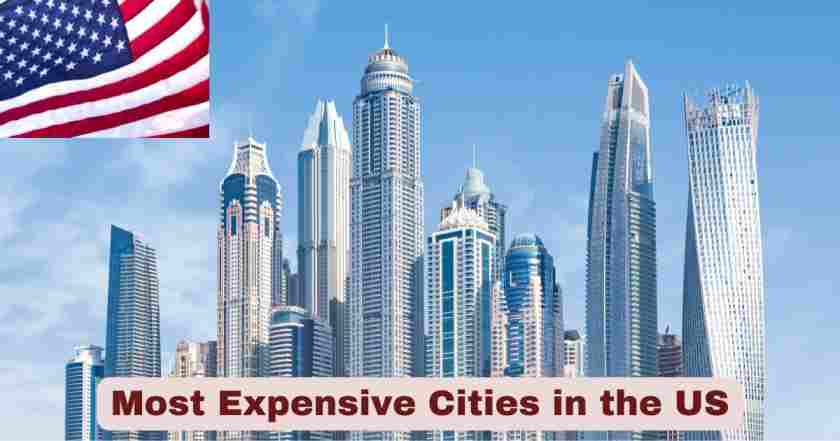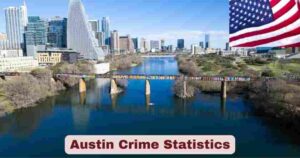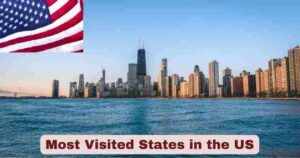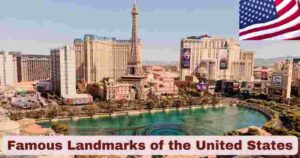Expensive Cities in the US 2025
The United States housing market and cost of living landscape continues to evolve dramatically in 2025, with certain metropolitan areas commanding premium prices that reflect their economic vitality, job opportunities, and quality of life. Understanding the most expensive cities in the US has become crucial for professionals, families, and investors making relocation decisions or evaluating real estate investments.
Rising inflation, limited housing supply, and increasing demand for urban amenities have pushed living costs to unprecedented levels across major American cities. According to recent Bureau of Labor Statistics data, the Consumer Price Index rose 2.7 percent over the last 12 months, with housing costs representing the largest component of this increase.
This comprehensive guide examines the 2025 landscape of America’s priciest urban markets, analyzing government data, housing trends, and economic factors that make these cities among the most expensive places to live in the United States.
Stats & Facts About Expensive Cities in the US 2025
| Economic Indicator | National Average | Expensive Cities Average | Difference |
|---|---|---|---|
| Median Home Price | $420,000 | $1,200,000 | +186% |
| Average Rent (1BR) | $1,400 | $2,800 | +100% |
| Required Income | $75,000 | $180,000 | +140% |
| Cost of Living Index | 100 | 165 | +65% |
| Housing Cost Ratio | 28% | 45% | +61% |
| Transportation Costs | $9,500 | $12,500 | +32% |
| Utilities Average | $150 | $220 | +47% |
| Grocery Costs | $4,200 | $5,800 | +38% |
The cost of living in America’s most expensive cities has reached historic proportions in 2025, with housing costs alone consuming 40-60% of median household income in top-tier markets. Government data reveals that these premium markets continue to outpace national averages across multiple economic indicators.
Housing affordability has become the primary driver of high living costs, with median home prices in the most expensive markets exceeding $1 million. The Bureau of Labor Statistics tracks regional price variations through the Consumer Price Index, showing significant disparities between metropolitan areas.
Income requirements for comfortable living in expensive cities have escalated dramatically, with financial experts recommending annual household incomes of $150,000-$300,000 for middle-class lifestyle maintenance in top-tier markets. This represents a 25-40% increase from pre-pandemic requirements.
Regional concentration of expensive cities remains heavily weighted toward coastal areas, particularly California and the Northeast corridor, though emerging markets in Texas, Florida, and Colorado have joined the high-cost category.
Most Expensive Cities in the U.S
| Rank | City | State | Median Home Price | Average Rent | Cost Index | Key Industries |
|---|---|---|---|---|---|---|
| 1 | New York City | NY | $1,350,000 | $3,500 | 187 | Finance, Tech, Media |
| 2 | San Francisco | CA | $1,400,000 | $3,200 | 179 | Technology, Biotech |
| 3 | Los Angeles | CA | $950,000 | $2,800 | 168 | Entertainment, Tech |
| 4 | San Jose | CA | $1,600,000 | $3,000 | 175 | Technology, Aerospace |
| 5 | Boston | MA | $850,000 | $2,700 | 165 | Education, Healthcare |
| 6 | Seattle | WA | $800,000 | $2,400 | 158 | Technology, Aerospace |
| 7 | Miami | FL | $650,000 | $2,900 | 155 | Finance, Tourism |
| 8 | San Diego | CA | $900,000 | $2,600 | 162 | Defense, Tourism |
| 9 | Honolulu | HI | $1,100,000 | $2,500 | 172 | Tourism, Military |
| 10 | Washington DC | DC | $750,000 | $2,600 | 160 | Government, Tech |
| 11 | Portland | OR | $600,000 | $2,200 | 148 | Technology, Manufacturing |
| 12 | Denver | CO | $580,000 | $2,100 | 145 | Energy, Aerospace |
| 13 | Santa Barbara | CA | $1,200,000 | $2,800 | 170 | Tourism, Agriculture |
| 14 | Anaheim | CA | $850,000 | $2,400 | 156 | Tourism, Manufacturing |
| 15 | Oakland | CA | $800,000 | $2,500 | 159 | Technology, Logistics |
| 16 | Austin | TX | $550,000 | $2,000 | 142 | Technology, Government |
| 17 | Nashville | TN | $480,000 | $1,900 | 138 | Healthcare, Entertainment |
| 18 | Providence | RI | $450,000 | $1,800 | 135 | Education, Healthcare |
| 19 | Riverside | CA | $620,000 | $2,200 | 149 | Logistics, Agriculture |
| 20 | Salt Lake City | UT | $520,000 | $1,750 | 140 | Technology, Finance |
1. New York City, NY: Manhattan’s limited land drives extreme housing costs, with studio apartments averaging $2,500 monthly. Wall Street salaries support premium pricing across restaurants, transportation, and services. Parking costs $400-600 monthly, while dining out averages $35 per meal. The city’s 24/7 lifestyle demands premium wages, making basic groceries cost 40% above national averages, yet professional opportunities justify expenses for many residents.
2. San Francisco, CA: Tech industry wealth inflates all living costs beyond national norms. Victorian homes sell for $2+ million, while one-bedroom rentals exceed $3,500. Coffee costs $6, casual dining $30 per person. Proximity to Silicon Valley creates bidding wars for housing. High salaries in technology offset costs, but service workers struggle with 50% higher grocery prices and $200+ monthly transit passes.
3. Los Angeles, CA: Entertainment industry and tech expansion drive housing premiums across diverse neighborhoods. Beach proximity commands $1+ million for modest homes. Traffic necessitates expensive car ownership with $300+ monthly parking and premium gas prices. Restaurant culture means frequent $25+ meals, while grocery costs run 35% above average. Despite high costs, career opportunities and year-round climate attract professionals willing to pay premiums.
4. San Jose, CA: Silicon Valley’s heart experiences the nation’s highest housing costs, with median homes at $1.6 million. Tech salaries justify expenses, but teachers and service workers face displacement. Restaurants reflect tech wealth with $40+ casual dining. Gas, utilities, and groceries all exceed national averages by 30-50%. Limited housing supply creates intense competition, pushing families toward longer commutes or smaller living spaces.
5. Boston, MA: Education and healthcare industries support premium pricing across historic neighborhoods. Winters increase utility costs significantly, while limited parking creates $250+ monthly expenses. Restaurant scene commands $30+ for casual dining, with craft beer costing $8+ per drink. University presence inflates rental markets, making one-bedrooms $2,700 monthly. Public transit helps offset some transportation costs but requires $90+ monthly passes.
6. Seattle, WA: Amazon and Microsoft fuel rapid cost escalation across the metropolitan area. Rain increases indoor entertainment costs, while coffee culture means $5+ daily expenses. Housing appreciation outpaces income growth, forcing longer commutes. Restaurants reflect tech wealth with $35+ average meals. State income tax absence helps offset some costs, but sales tax and property taxes remain high, impacting overall affordability.
7. Miami, FL: International finance and luxury tourism create dual-economy pricing structures. Waterfront properties exceed $1 million, while hurricane insurance adds $3,000+ annually. Restaurant scene caters to wealthy tourists with $40+ dining expectations. No state income tax helps, but sales tax and luxury goods pricing offset benefits. Air conditioning costs $200+ monthly year-round, while premium lifestyle expectations drive entertainment expenses higher.
8. San Diego, CA: Year-round perfect weather commands premium pricing for housing near beaches. Defense contractors and biotech support high-wage employment. Casual dining averages $28 per person, while craft beer culture adds entertainment costs. Limited housing supply creates bidding wars. Gas prices exceed $5 per gallon, while parking downtown costs $15+ daily. Outdoor lifestyle requires gear investments but reduces some indoor entertainment costs.
9. Honolulu, HI: Island isolation creates import-dependent economy with extreme grocery costs 60% above mainland. Housing limited by geography drives median prices over $1 million. Restaurant meals average $35+ due to import costs and tourism. Utilities cost $300+ monthly due to expensive electricity. Paradise tax means paying premiums for basic necessities, though outdoor activities provide free entertainment options year-round.
10. Washington DC, DC: Government contractor salaries support premium pricing throughout metropolitan area. Housing costs reflect federal employee income levels, with condos averaging $750,000. Restaurant scene caters to expense accounts with $40+ business meals. Metro system requires $100+ monthly passes, while downtown parking exceeds $300 monthly. Political networking culture increases entertainment and professional development expenses significantly for career advancement.
11. Portland, OR: Tech expansion drives gentrification and housing cost increases throughout established neighborhoods. Food truck culture and craft brewing create premium dining expectations averaging $25+ meals. No sales tax helps offset some costs, but state income tax and property taxes remain substantial. Coffee culture means $5+ daily expenses, while bike-friendly infrastructure reduces some transportation costs but increases gear and maintenance expenses.
12. Denver, CO: Energy sector boom and outdoor lifestyle attract high-earning professionals driving housing competition. Mountain proximity increases recreation costs with ski passes exceeding $2,000 annually. Craft beer scene averages $7+ per drink, while restaurant costs reflect affluent demographics. Altitude increases utility costs for heating and cooling, while outdoor gear represents significant lifestyle investments for active residents.
13. Santa Barbara, CA: Coastal location and university presence create artificial housing scarcity with homes exceeding $1.2 million. Wine country proximity drives restaurant expectations above $35 per person. Limited commercial development restricts shopping options, increasing prices. Beach lifestyle requires premium for proximity, while university students compete for limited rental inventory. Tourism inflates all service costs during peak seasons significantly.
14. Anaheim, CA: Disneyland proximity drives tourism-based economy with inflated service costs year-round. Housing costs reflect Southern California premiums despite suburban location. Restaurant pricing caters to tourist expectations with $25+ family meals. Theme park employment creates service-based economy with limited high-wage opportunities, creating affordability challenges for local workers. Tourist traffic increases transportation costs and time investments.
15. Oakland, CA: San Francisco overflow drives rapid gentrification and housing cost increases throughout diverse neighborhoods. Port activity creates logistics employment but tech commuters inflate housing demand. Restaurant scene reflects Bay Area wealth with $30+ dining expectations. Crime concerns increase security costs, while proximity to San Francisco creates expensive commute requirements. Limited parking downtown costs $200+ monthly.
16. Austin, TX: Tech expansion creates rapid cost escalation in traditionally affordable markets. Music scene drives entertainment culture with frequent $20+ show tickets. No state income tax helps offset costs, but property taxes exceed many coastal areas. Food truck culture and craft brewing scene average $15+ meals. Rapid growth creates infrastructure strain, increasing transportation time and costs significantly for residents.
17. Nashville, TN: Healthcare headquarters and music industry create diverse high-wage employment supporting premium pricing. Entertainment district drives tourism-inflated restaurant costs averaging $25+ per person. No state income tax helps affordability, but sales tax and property tax increases offset benefits. Music culture requires instrument and venue investments, while networking events increase professional entertainment expenses for industry workers.
18. Providence, RI: Education and healthcare employment support modest premium pricing in historic New England city. University presence inflates rental markets during academic year, creating seasonal price fluctuations. Restaurant scene reflects student and professional demographics with $22+ average meals. Winter heating costs add $150+ monthly utility expenses, while limited parking downtown creates $100+ monthly costs for residents.
19. Riverside, CA: Logistics hub location creates employment opportunities but housing costs reflect Southern California regional premiums. Desert climate increases cooling costs $200+ monthly during summer peaks. Restaurant options limited compared to coastal areas but still reflect California pricing at $20+ meals. Commuting to Los Angeles or Orange County creates significant transportation expenses and time investments for many residents.
20. Salt Lake City, UT: Technology sector growth drives rapid housing appreciation in mountain-adjacent locations. Outdoor recreation culture requires gear investments exceeding $3,000 annually for active lifestyles. Restaurant scene caters to young professionals with $25+ dining expectations. Winter heating costs substantial, while air quality concerns during inversion periods increase health-related expenses. Limited alcohol availability increases entertainment costs through restaurant premiums.
Housing Market Analysis: Primary Cost Driver
Housing Market Breakdown
| Housing Category | Expensive Cities | National Average | Premium |
|---|---|---|---|
| Single Family Home | $1,200,000 | $420,000 | 186% |
| Condominium | $850,000 | $280,000 | 204% |
| 1-Bedroom Rental | $2,800 | $1,400 | 100% |
| 2-Bedroom Rental | $4,200 | $1,800 | 133% |
| Luxury Rental | $6,500 | $2,500 | 160% |
| Property Tax Rate | 1.8% | 1.1% | 64% |
| HOA Fees | $450 | $200 | 125% |
| Utilities | $220 | $150 | 47% |
Housing represents the single largest expense component in expensive U.S. cities, typically accounting for 45-60% of household budgets compared to the recommended 28-30% nationally. The shortage of available housing inventory has created intense competition among buyers and renters, driving prices to unprecedented levels.
Median home prices in top-tier markets have appreciated 15-25% annually over the past three years, far outpacing income growth and inflation rates. This appreciation reflects fundamental supply-demand imbalances that show little sign of resolution in the near term.
Rental markets mirror purchase price trends, with average one-bedroom apartments commanding $2,500-$3,500 monthly in the most expensive cities. Luxury units and premium locations frequently exceed $5,000-$8,000 monthly, creating affordability challenges for middle-income residents.
Government intervention through zoning reforms and housing incentives has shown limited impact on moderating housing costs in expensive markets. Local regulations, environmental constraints, and community resistance to density increases continue limiting new supply development.
Transportation and Infrastructure Costs
Transportation Cost Analysis
| Transportation Item | Expensive Cities | National Average | Premium |
|---|---|---|---|
| Monthly Transit Pass | $150 | $75 | 100% |
| Monthly Parking | $350 | $100 | 250% |
| Gas Price per Gallon | $4.80 | $3.50 | 37% |
| Car Insurance | $2,400 | $1,600 | 50% |
| Ride Share Trip | $25 | $15 | 67% |
| Bike Share Monthly | $180 | $95 | 89% |
| Vehicle Registration | $400 | $150 | 167% |
| Toll Roads Annual | $1,200 | $300 | 300% |
Transportation expenses in expensive cities significantly exceed national averages, driven by premium fuel costs, parking fees, and comprehensive public transit systems. Urban density and traffic congestion create unique transportation challenges that impact household budgets substantially.
Public transportation systems, while extensive, command premium pricing in expensive metropolitan areas. Monthly transit passes typically cost $100-$200 compared to $50-$75 in smaller cities, though they provide access to comprehensive rail and bus networks.
Vehicle ownership costs escalate dramatically in expensive cities through parking fees, insurance premiums, and maintenance expenses. Monthly parking can cost $200-$500 in downtown areas, making car ownership prohibitively expensive for many residents.
Alternative transportation options including ride-sharing and bike-sharing services have proliferated but add to overall transportation expenses. These services typically cost 50-100% more than comparable options in less expensive markets.
Food and Dining Costs
| Food Category | Expensive Cities | National Average | Premium |
|---|---|---|---|
| Grocery Weekly | $140 | $100 | 40% |
| Casual Dining | $25 | $18 | 39% |
| Fine Dining | $125 | $75 | 67% |
| Coffee Shop | $6 | $4 | 50% |
| Food Delivery | $35 | $22 | 59% |
| Farmers Market | $45 | $25 | 80% |
| Wine/Alcohol | $18 | $12 | 50% |
| Specialty Items | $8 | $5 | 60% |
Restaurant dining and grocery costs in expensive U.S. cities reflect premium real estate, higher labor costs, and sophisticated culinary markets. Food expenses typically run 30-50% higher than national averages, with fine dining and specialty groceries commanding significant premiums.
Grocery shopping costs increase substantially due to higher commercial rents, transportation expenses, and labor costs that retailers pass to consumers. Specialty and organic products, popular in expensive metropolitan markets, further elevate food expenses.
Restaurant pricing reflects expensive city economics, with casual dining averaging $20-$30 per person and fine dining frequently exceeding $100-$150 per person. These prices reflect not only ingredient costs but also premium real estate and service wages.
Food delivery services add convenience but significant expense, with delivery fees, tips, and service charges often doubling meal costs. The popularity of these services in expensive cities reflects time-pressed lifestyles but contributes to elevated living expenses.
Healthcare and Education Expenses
| Healthcare/Education | Expensive Cities | National Average | Premium |
|---|---|---|---|
| Health Insurance | $850 | $600 | 42% |
| Primary Care Visit | $350 | $250 | 40% |
| Specialist Visit | $500 | $350 | 43% |
| Private School K-12 | $45,000 | $25,000 | 80% |
| Childcare Monthly | $2,800 | $1,500 | 87% |
| College Prep | $150/hr | $80/hr | 88% |
| Dental Cleaning | $180 | $125 | 44% |
| Prescription Drugs | $65 | $45 | 44% |
Healthcare costs in expensive cities reflect premium medical facilities, specialized services, and higher operational expenses. While residents often access world-class medical care, the associated costs significantly exceed national averages across all service categories.
Private school tuition and childcare expenses represent major budget items for families in expensive cities. Elite private schools frequently charge $30,000-$60,000 annually, while quality childcare can exceed $2,000-$3,000 monthly per child.
Healthcare insurance premiums and out-of-pocket expenses trend higher due to elevated provider costs and comprehensive coverage requirements. Specialist consultations and elective procedures command premium pricing in competitive metropolitan markets.
Educational opportunities, while extensive and high-quality, come with significant financial commitments. From private school tuition to enrichment activities and tutoring, educational expenses can consume substantial portions of household budgets.
Entertainment and Lifestyle Costs
| Entertainment Category | Expensive Cities | National Average | Premium |
|---|---|---|---|
| Movie Theater | $18 | $12 | 50% |
| Concert Tickets | $120 | $75 | 60% |
| Gym Membership | $180 | $90 | 100% |
| Theater Show | $150 | $85 | 76% |
| Museum Membership | $200 | $100 | 100% |
| Sporting Event | $250 | $125 | 100% |
| Nightlife Average | $80 | $45 | 78% |
| Weekend Activities | $200 | $100 | 100% |
Entertainment and recreational activities in expensive cities offer world-class experiences at premium prices. Concert venues, sporting events, theater productions, and cultural attractions command higher ticket prices while providing access to exclusive entertainment options unavailable elsewhere.
Fitness and wellness services reflect the health-conscious culture of expensive metropolitan areas, with boutique fitness studios, personal training, and wellness services priced significantly above national averages. Premium gym memberships can cost $150-$300 monthly.
Social and networking activities essential for career advancement often require significant entertainment budgets. Business dinners, networking events, and professional social gatherings contribute substantially to living expenses in competitive urban markets.
Cultural amenities including museums, galleries, and performance venues offer exceptional programming but require dedicated budget allocation. Season tickets and memberships to cultural institutions represent significant annual expenses for engaged residents.
Regional Economic Factors
| Economic Factor | Impact on Costs | Examples | Contribution % |
|---|---|---|---|
| Tech Industry | Very High | San Francisco, Seattle | 35% |
| Finance | High | New York, Boston | 25% |
| Geography | High | Manhattan, SF Peninsula | 20% |
| Climate | Medium | San Diego, Miami | 10% |
| Culture | Medium | NYC, LA | 15% |
| Government | Medium | Washington DC | 12% |
| Tourism | Medium | Honolulu, Santa Barbara | 8% |
| Education | Low | Boston, Providence | 5% |
Technology sector concentration drives expense levels in multiple expensive U.S. cities, creating high-paying employment opportunities that support premium pricing across all service sectors. Silicon Valley, Seattle, and Austin exemplify this dynamic with technology companies anchoring local economies.
Financial services industries in New York, Boston, and Chicago generate substantial wealth that supports expensive local markets. Investment banking, asset management, and financial technology companies provide employment opportunities justifying elevated living costs.
Geographic constraints limit housing supply development in many expensive cities, from Manhattan’s island location to San Francisco’s peninsula geography. These natural boundaries create artificial scarcity that supports premium pricing indefinitely.
Climate and lifestyle factors attract residents willing to pay premiums for year-round outdoor activities, cultural amenities, and professional opportunities. Cities like San Diego, Miami, and Santa Barbara leverage climate advantages to command higher living costs.
Income Requirements and Affordability
| Income Level | Lifestyle Supported | Housing Options | Monthly Budget |
|---|---|---|---|
| $80,000 | Student/Entry Level | Shared Housing | $6,700 |
| $120,000 | Young Professional | 1-BR Rental | $10,000 |
| $180,000 | Mid-Career | 2-BR Rental/Condo | $15,000 |
| $250,000 | Established Professional | Single Family | $20,800 |
| $350,000 | Senior Executive | Premium Housing | $29,200 |
| $500,000+ | Top Earner | Luxury Options | $41,700+ |
Financial experts recommend annual household incomes of $150,000-$300,000 for comfortable middle-class living in America’s most expensive cities. These recommendations account for housing, transportation, food, healthcare, and discretionary spending requirements.
Housing affordability calculations reveal that median-income families cannot afford median-priced homes in most expensive markets without significant down payment assistance or dual high-paying careers. This affordability gap continues widening as home prices outpace income growth.
Housing Cost Allocation by Income Level:
| Household Needs | Basic | Comfortable | Luxury |
|---|---|---|---|
| Housing | 45% | 35% | 25% |
Rental affordability requires household incomes of $120,000-$180,000 for average one-bedroom apartments in expensive cities, assuming the standard 30% housing cost ratio. Many residents exceed recommended ratios, dedicating 40-50% of income to housing expenses.
Savings and investment capacity diminishes significantly for residents of expensive cities, even among high earners. After accounting for basic living expenses, discretionary income often falls below levels achieved by moderate earners in less expensive markets.
Future Trends and Predictions
| Trend Category | 2025-2030 Impact | Affected Cities | Probability |
|---|---|---|---|
| Remote Work | Moderate Decrease | SF, Seattle, NYC | High |
| Climate Risk | Cost Increase | Miami, LA, SF | Medium |
| Infrastructure | Cost Decrease | All Major | Medium |
| Zoning Reform | Housing Relief | SF, LA, NYC | Low |
| Industry Shift | Mixed Impact | Tech Cities | Medium |
| Population Migration | Cost Moderation | Coastal Cities | Medium |
| Interest Rates | Variable | All Markets | High |
| Government Policy | Mixed | All Markets | Medium |
Remote work adoption may moderate expensive city premiums as professionals gain flexibility to live in lower-cost markets while maintaining high-paying employment. This trend could reduce demand pressure in traditional expensive metropolitan areas over the medium term.
Climate change considerations increasingly influence expensive city attractiveness, with coastal markets facing long-term flooding risks and western cities confronting wildfire dangers. These environmental factors may reshape expensive city rankings over the next decade.
Infrastructure investments in transportation and housing could alleviate some cost pressures in expensive markets. High-speed rail connections and zoning reform initiatives show potential for moderating housing scarcity in constrained markets.
Economic diversification efforts in expensive cities aim to reduce dependence on single industries that drive current high costs. Success in attracting diverse employers could moderate extreme cost escalation while maintaining economic vitality.
Future Trends
The landscape of most expensive cities in the US in 2025 reflects complex economic forces including industry concentration, geographic constraints, and lifestyle preferences that continue driving premium pricing across multiple metropolitan markets. San Jose, California, maintains its position as the most expensive metro area for U.S. homebuyers, while traditional expensive markets like New York City and San Francisco retain their positions among America’s priciest urban areas.
Understanding these cost dynamics remains crucial for career and lifestyle decisions, as the financial requirements for comfortable living in expensive cities have escalated significantly beyond national averages. Professional opportunities and cultural amenities in these markets often justify premium costs for many residents, but careful financial planning becomes essential for sustainable urban living.
Future trends suggest potential moderation in expensive city premiums through remote work adoption, infrastructure improvements, and policy interventions, though fundamental supply-demand imbalances may persist in the most constrained markets. Prospective residents and investors should carefully evaluate total cost of ownership and lifestyle trade-offs when considering expensive metropolitan areas.
The most expensive cities in the US will likely maintain their premium status through 2025 and beyond, supported by economic vitality, geographic advantages, and quality of life factors that attract high-earning professionals willing to pay substantial premiums for urban amenities and career opportunities.
Disclaimer: The data research report we present here is based on information found from various sources. We are not liable for any financial loss, errors, or damages of any kind that may result from the use of the information herein. We acknowledge that though we try to report accurately, we cannot verify the absolute facts of everything that has been represented.







